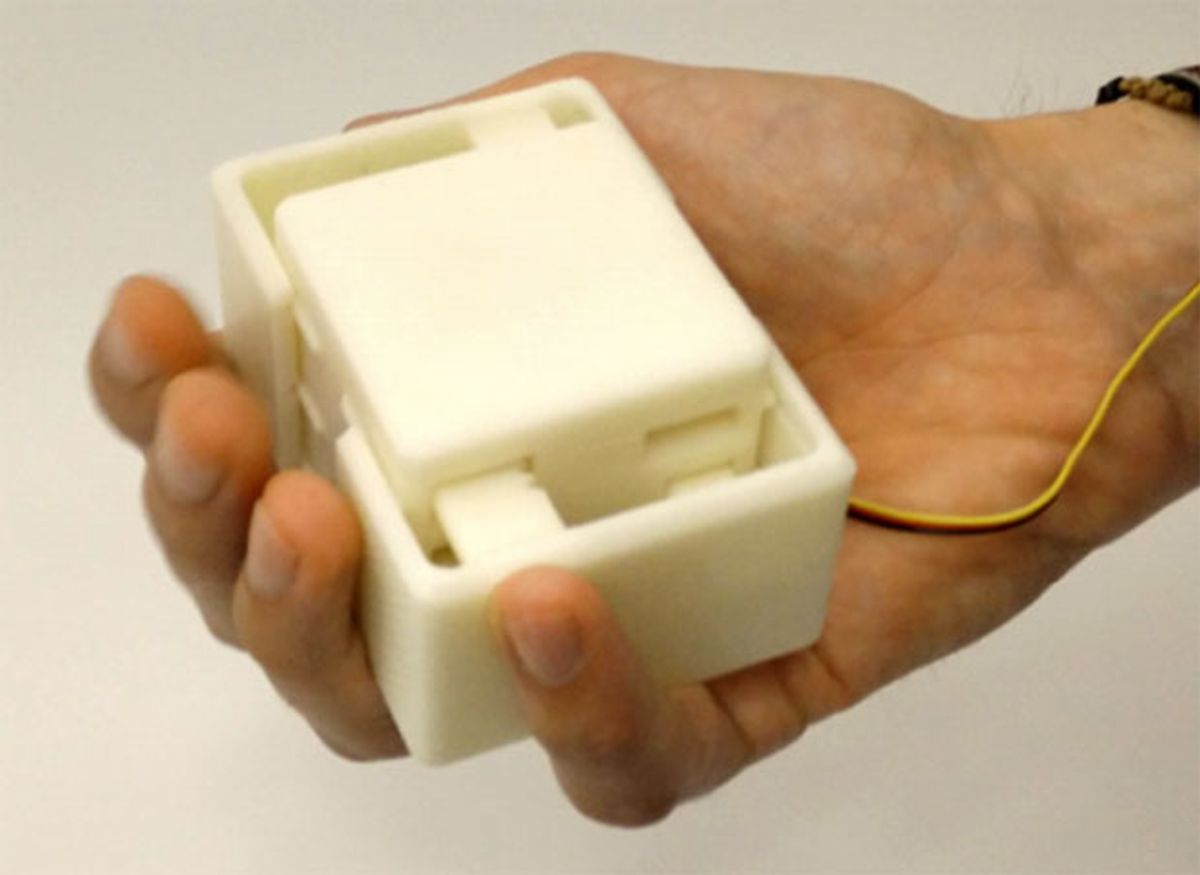Using technology to navigate around an urban area completely monopolizes, at minimum, one of your senses. Either you're staring at a map on your phone or the car’s center console, or listening to spoken directions through headphones or the car speakers. If you're truly inept at navigating, you might need to see and listen at the same time. Unfortunately, your eyes and ears come in handy for other things, like not smashing into lamp posts or avoiding getting plowed into by other vehicles.
Adam J. Spiers, a member of the GRAB Lab at Yale, has been developing small haptic peripherals that are designed to help drivers navigate using touch alone. He presented his latest research last month at the IEEE Robotics and Automation Society’s International Conference on Robotics and Automation in Stockholm, Sweden. In a paper titled Development and Experimental Validation of a Minimalistic Shape-Changing Haptic Navigation Device, he and several collaborators described the “Haptic Taco,” a little cube that expands and contracts in your hand to lead you straight to your destination.
The Haptic Taco is the most recent version of a series of haptic navigation aids that Spiers has developed over the past several years. These include a “Haptic Lotus” and another cube-shaped thing called Animotus (aka the “Haptic Sandwich”), both of which can be seen in the video below:
Why's it called a “Haptic Taco?” From the paper:
The device name comes from the vague ‘hard taco shell’ shape of the expanding sections. These sections were designed with ‘C’ shaped outer walls, to negate pinching hazards and provide a continuous contour around the side of the device. The continuous contour improves the haptic impression of the device modifying its volume, rather than simple linear motion of two faces.
Well, okay then.
As a “variable volume” device, the Haptic Taco’s functionality is based entirely on growing and shrinking. To navigate with it, you simply pair it with a navigation app on your phone, and hold it in your hand. It’ll maximize its volume into a rectangular prism, and then slowly shrink itself back down to a cube as you move toward your destination. If you take a wrong turn, it’ll start to grow again. It’s an absurdly simple method of proximity-based navigation, just like the game of “hotter / colder” that you probably played when you were a kid. It may be occasionally tricky to use in practice (you might have to “hunt” with it a bit), but it’s intuitive even for inexperienced users and it works perfectly well if you’ve got your hand in a pocket.
Generally, when we hear the word “haptic,” we think of things like the vibratory buzzing that our phones use to alert us through touch. And you could certainly use something like that for in-pocket navigation: an object that buzzes more or less depending on whether you’re headed in the right direction or not. That sounds unpleasant, though, and the Haptic Taco was developed specifically to be less obtrusive. As Spiers notes in his ICRA paper, the aim is to provide intuitive but not distracting sensations.
We believe this would make a system more appealing for longer term use than the more ‘alert-based’ methods of haptic feedback. In particular, it was considered that alerting stimuli could get tiring over the extended periods of time often associated with pedestrian navigation.
To evaluate how well the Haptic Taco worked, a group of users was asked to navigate around a series of invisible points in a small room. The graphs below show some sample paths that people took to each point following the Taco’s guidance versus the direct path:
On average, using the Haptic Taco was about half as efficient as taking straight line paths, which probably sounds worse than it would be in practice, especially over longer distances. Interestingly, the 1-degree-of-freedom Haptic Taco did just as well as the Haptic Sandwich, which has two degrees of freedom—suggesting that providing less information to the user doesn’t necessarily lead to worse navigation performance.
The prototype in the picture and video cost about a hundred bucks to put together, which means that if the Haptic Taco were ever turned into an actual product, it would likely be very inexpensive. Spiers says he’s working on making it smaller, too, even as he continues to test it in more realistic outdoor and urban environments.
Evan Ackerman is a senior editor at IEEE Spectrum. Since 2007, he has written over 6,000 articles on robotics and technology. He has a degree in Martian geology and is excellent at playing bagpipes.




